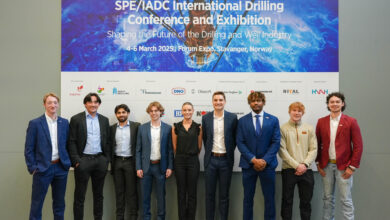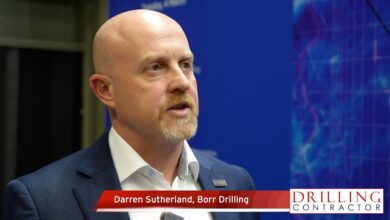Technical Session 1 – Drilling Project Case Study
Editor’s note: These abstracts have been edited for space and clarity. This program is current as of 15 January 2013. Additions, withdrawals and other changes to the conference program after this date may not be reflected. Click here for the most updated program.
TECHNICAL SESSION I: DRILLING PROJECT CASE STUDY
SPE/IADC 163525
Setting Free the Bear: The Challenges and Lessons of the Ursa A-10 Deepwater ERD Well, E. van Oort, University of Texas Austin; G.A. Ugueto, J.R. Gradishar, J. Murdoch, Shell
This paper details the case history of the challenging extended reach deepwater A-10 well, drilled in the Ursa prospect in the Gulf of Mexico. This well, drilled from the Ursa TLP at a vertical depth of 20,000 ft and a horizontal displacement of 20,000 ft, targeted the yellow sand in the Ursa-Princess section of the greater Mars-Ursa basin. During the drilling of the original hole and three subsequent sidetracks, significant hole problems materialized causing extensive non-productive time and associated trouble cost. A succinct overview of the Ursa A-10 case history and a comprehensive summary of the learnings will be provided in the paper to help the future drilling of extended reach wells in geopressured, low-margin deepwater environments.
SPE/IADC 163487
Case History of a Challenging Thin Oil Column ERD Development at Sakhalin, V.P. Gupta, S.R. Sanford, ExxonMobil Development Company; R.S. Mathis, E.K. DiPippo, Exxon Neftegas; M.J. Egan, AIPC, Consultant
ExxonMobil, as operator for the Sakhalin-1 project, recently planned a drilling campaign at the Chayvo Field, Sakhalin Island, Russia. The focus of this campaign is the development of a thin oil column reservoir using extended reach drilling (ERD).
The case history described in this paper illustrates the combination of planning, technical design and operational practices required to push the ERD envelope further.
SPE/IADC 163456
White Rose Project Drilling and Completion Performance Evolution: A Case Study, G. Akinniranye, T. Krepp, B.M. Foster, K&M Technology Group; C. Pardy, Husky Energy; M. Carter, Schlumberger; C.C. Gregory, Canada Husky Energy
The White Rose field is a large oilfield offshore Eastern Canada, approximately 350 km east-southeast of St John’s Newfoundland. The North Amethyst Drill Center was the first satellite tie-back development of the main White Rose field.
North Amethyst faces significant drilling challenges. In earlier wells, the severe levels of shocks and vibrations encountered while drilling both the intermediate and production hole sections resulted in low rates of penetration, premature bit wear, damaged tools, unplanned trips and drill string failures.
This paper presents a deconstruction of how drilling and completion performance improvements were achieved over three years from 2009 to 2012. These efforts, even as wells complexities increase, reduced cost per foot and days per thousand feet by over 20% while drilling approximately eight wells over a two-year period.
SPE/IADC 163447
Shale Play Drilling Challenges: Case Histories and Lessons Learned, M.J. Jellison, J.N. Brock, A. Muradov, D. Morgan, NOV Grant Prideco; J. Rowell, Premium Oilfield Services
This paper discusses the requirements for drill pipe in shale applications along with a review of some of the challenges and problems associated with the drill string in these critical applications.
SPE/IADC 163415
Exploration and Appraisal Drilling Operations in the South Atlantic, J.W. Jenner, A. Morrison, Rockhopper Exploration; B. Lyons, Desire Petroleum; L. Phillips, AGR Petroleum Services; I. McBean, Diamond Offshore Drilling (UK)
The paper describes how the teamwork and continuity provided by utilizing a drilling project management company based in Aberdeen and a single drilling contractor enabled two small UK operating companies, with limited in-house operational resources, to conduct offshore drilling campaigns in an area remote from established support centers.
The paper will demonstrate that with detailed and careful planning, inclusive management and modern communications technology, drilling operations in remote locations can be conducted safely and efficiently.

9 5/8-in. and 7-in. liners in place from the naturally fractured El Abra formation in the Carpa and Bagre fields of the Faja de Oro area offshore Mexico.
SPE/IADC 163418
Use of Liner Drilling Technology as a Mitigation to Lost Circulation in the Faja De Oro (Golden Lane) Oil Fields Offshore Veracruz, Mexico, O.L. Pohlenz, Pemex Exploration and Production; S.M. Rosenberg, E. Garcia, M.Z. Tan, Weatherford International
This paper will demonstrate the benefit of liner drilling technology to drill and cement an operator’s 9 5/8-in. and 7-in. liners in place allowing for the continued development of oil reserves from the naturally fractured El Abra formation in the Carpa and Bagre fields of the Faja de Oro area.
Prior to the introduction of liner drilling, two previous wells drilled in the Carpa field encountered massive lost circulation and hole instability while drilling into the El Abra limestone resulting in a total of 55 days of NPT for the two wells. An estimated 2,700 bbls of fluid were lost in these wells with both wells having to be sidetracked to reach their El Abra objective.
E-POSTERS:
SPE/IADC 163443
First Oil Requirements Drive Simultaneous Drilling and Subsea Construction Operations on UK Central North Sea Development, R.M. Allan, B. Fraser, S. Short, S. Davidson, E.ON E&P UK
Accelerated production targets in the field development plan of this UKCS project drove the requirement for design and drilling of the four production and two injection wells with concurrent subsea construction and planned production start-up. The objective of the paper is to demonstrate that the use of a jackup with subsea template and high-pressure riser is a worthwhile subsea well development method.
The activities described in the paper can be applied to marginal developments where accelerated production is a driver or rig market constraints are a factor during rig type selection.
SPE/IADC 163457
Case Study of Rotating Expandable Reamer Across Whipstock and Drilling Ahead Over 8,000 ft Thereby Reducing Drilling Time, S.R. Radford, M. Allain, J. Oliveire, S. Desselle, Baker Hughes; B. Pearl, Chevron; J.D. Enterline, Hughes Christensen
Reducing drilling time and cost has become more important as wells have been drilled deeper and costs have risen. This paper will describe a case study of a well drilled in the Main Pass area of the Gulf of Mexico for a major operator. In this job it became necessary to rotate a bottomhole assembly, including an expandable reamer, across a whipstock. This eliminated a trip and significantly minimized costs.
SPE/IADC 163523
Operational Reliability Assessment of Conventional Drilling vs MPD on Challenging Offshore Wells, D.M. Hannegan, Weatherford International Ltd.
This presentation applies reliability engineering concepts to a HPHT prospect whose water depth and formation pressure map suggests risk of kick-loss scenarios, differential sticking, risk of twist-off, cementing challenges and TD with too small a hole. An offset well’s actual experience with conventional drilling methods will be compared with an operational reliability assessment of applying the constant bottom hole pressure variation of managed pressure drilling on the proposed well.




